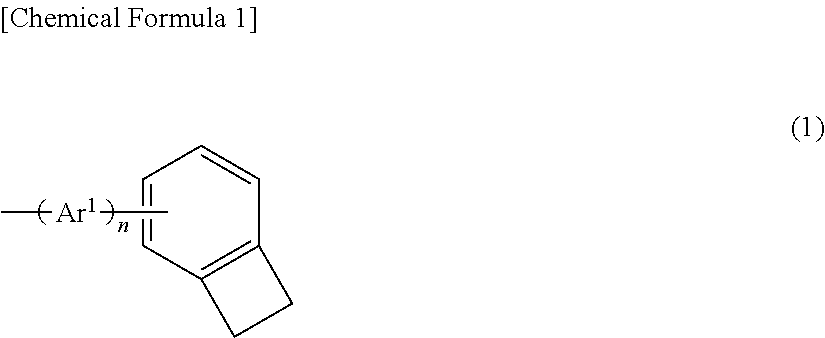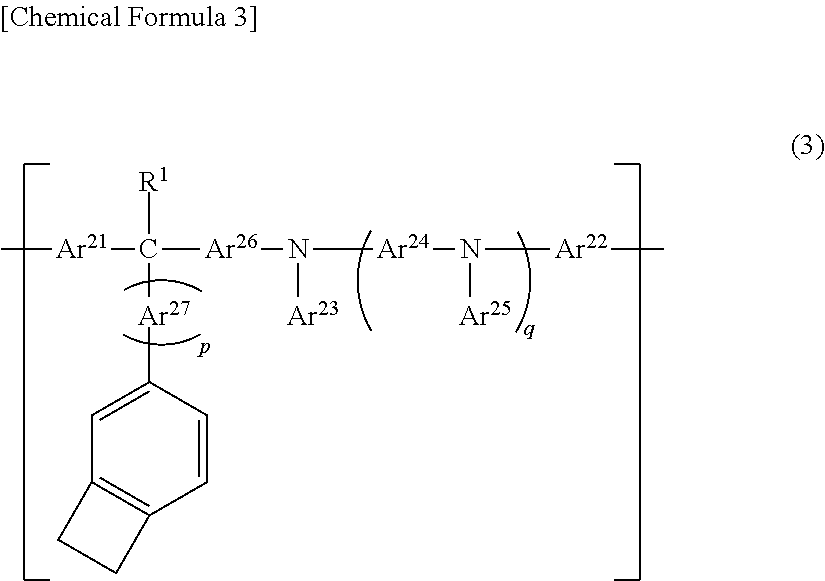Polymer compound, charge-transporting polymer, composition for organic electroluminescent element, organic electroluminescent element, organic el display device, and organic el light
a charge-transporting polymer and polymer compound technology, applied in the field of polymer compound, can solve the problems of poor driving stability of wet film-forming methods, inability to reach a practical level at present, and difficult lamination, and achieve the effects of preventing trapping, high hole-transporting ability, and excellent solubility in organic solvents
- Summary
- Abstract
- Description
- Claims
- Application Information
AI Technical Summary
Benefits of technology
Problems solved by technology
Method used
Image
Examples
example 1
[0251]
[0252]2,2-Bis[4-(4-bromophenyl)phenyl]-4-methylpentane (6.85 g, 12.50 mmol), 2-amino-9,9-dihexylfluorene (8.74 g, 25.00 mmol), sodium tert-butoxide (7.69 g, 80.00 mmol), and toluene (130 ml) were charged. The system was fully purged with nitrogen and heated to 60° C. (solution A). Tri-tert-butylphosphine (0.405 g, 2.00 mmol) was added to a 20-ml toluene solution of a tris(dibenzylideneacetone)dipalladium chloroform complex (0.259 g, 0.25 mmol) and heated to 60° C. (solution B). In a nitrogen gas stream, the solution B was added to the solution A, followed by heating at reflux to cause a reaction for 2.0 hours. Then, 2,2-bis[4-(4-bromophenyl)phenyl]-4-methylpentane (5.60 g, 8.56 mmol) and the compound 6 (1.04 g, 1.55 mmol) were further added thereto. After heating at reflux for 2.0 hours, the reaction mixture was allowed to cool and then added dropwise to 1,200 ml of ethanol to crystallize a crude polymer 1.
[0253]The obtained crude polymer 1 was dissolved in 350 ml of toluene. ...
example 2
[0258]
[0259]4,4″-Dibromo-p-terphenyl (8.100 g, 20.8709 mmol), 2-amino-9,9-dihexylfluorene (14.591 g, 41.7418 mmol), sodium tert-butoxide (15.464 g, 160.9147 mmol), and toluene (60 ml) were charged, and the system was fully purged with nitrogen and heated to 95° C. (solution A). Tri-tert-butylphosphine (1.140 g, 5.6351 mmol) was added to a 13-ml toluene solution of a tris(dibenzylideneacetone)dipalladium chloroform complex (0.432 g, 0.4174 mmol) and heated to 60° C. (solution B). In a nitrogen gas stream, the solution B was added to the solution A, followed by heating at reflux to cause a reaction for 2.0 hours. Confirming that 4,4″-dibromo-p-terphenyl and 2-amino-9,9-dihexylfluorene had disappeared, 4,4″-dibromo-p-terphenyl (7.160 g, 18.4499 mmol) and the compound 6 (1.259 g, 1.8784 mmol) were further added thereto. After heating at reflux for 1.0 hour, the reaction mixture was allowed to cool and then added dropwise to 3,000 ml of ethanol to crystallize a crude polymer 2.
[0260]The ...
example 3
[0279]By the following method, an organic electroluminescent element having the following layer structure was produced: (anode / hole injection layer / hole transport layer / light-emitting layer / electron injection layer / cathode).
[0280]A glass substrate having formed thereon a 70-nm-thick, transparent, electrically conductive film of indium-tin oxide (ITO) (film formed by sputtering, sheet resistance: 15Ω) was patterned into 2-mm-wide stripes by ordinary photolithography to form an anode. The patterned ITO substrate was ultrasonically cleaned with acetone, washed with pure water, and then ultrasonically cleaned with isopropyl alcohol. The substrate was then dried by nitrogen blowing and finally subjected to UV ozone cleaning.
[0281]First, a coating liquid for forming a hole injection layer containing a polymer represented by the following formula (H1) (Mw=70,000, Mn=40,000), 4-isopropyl-4′-methyldiphenyliodonium tetrakis(pentafluorophenyl)borate, and ethyl benzoate was prepared. The coatin...
PUM
| Property | Measurement | Unit |
|---|---|---|
| time | aaaaa | aaaaa |
| transmittance | aaaaa | aaaaa |
| transmittance | aaaaa | aaaaa |
Abstract
Description
Claims
Application Information
 Login to View More
Login to View More - R&D
- Intellectual Property
- Life Sciences
- Materials
- Tech Scout
- Unparalleled Data Quality
- Higher Quality Content
- 60% Fewer Hallucinations
Browse by: Latest US Patents, China's latest patents, Technical Efficacy Thesaurus, Application Domain, Technology Topic, Popular Technical Reports.
© 2025 PatSnap. All rights reserved.Legal|Privacy policy|Modern Slavery Act Transparency Statement|Sitemap|About US| Contact US: help@patsnap.com



